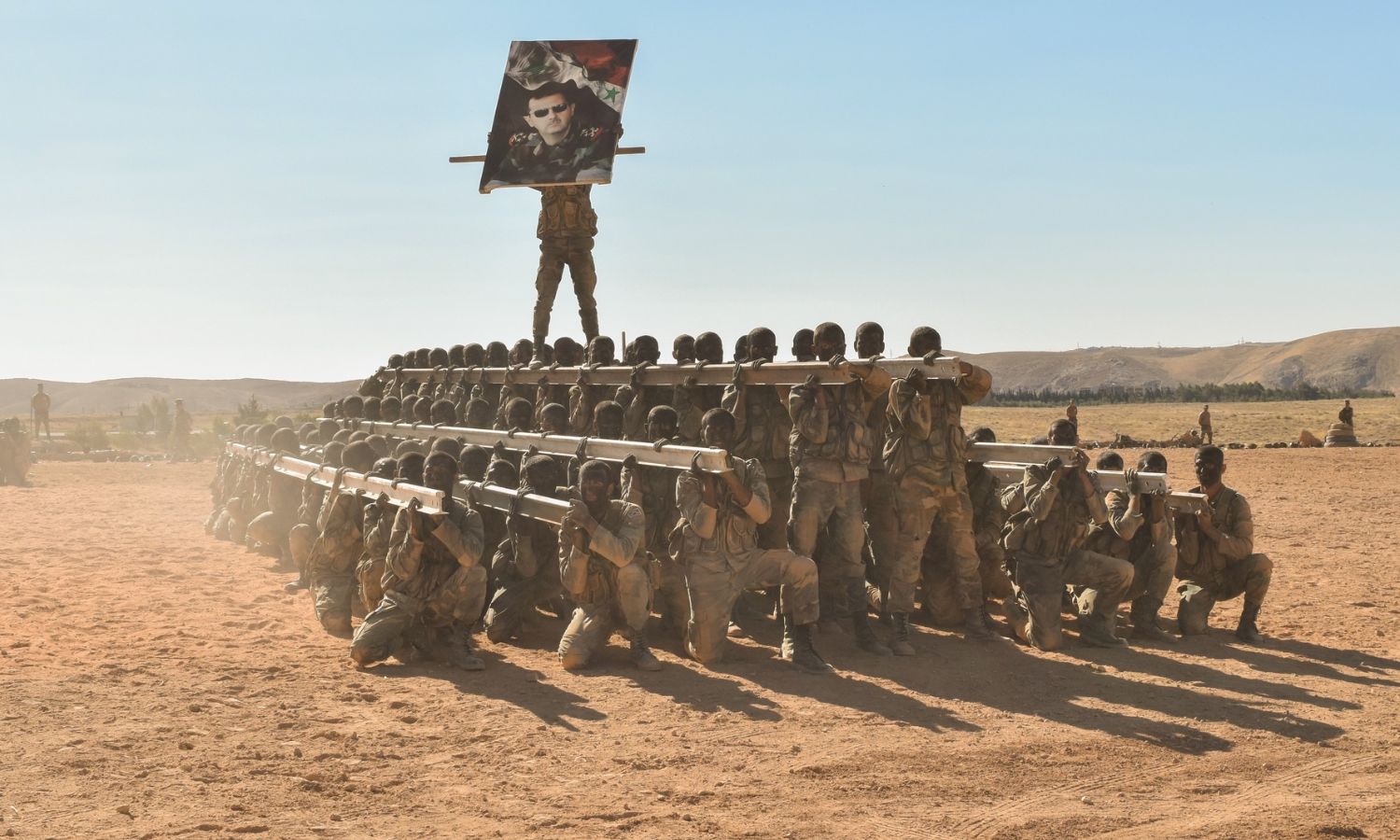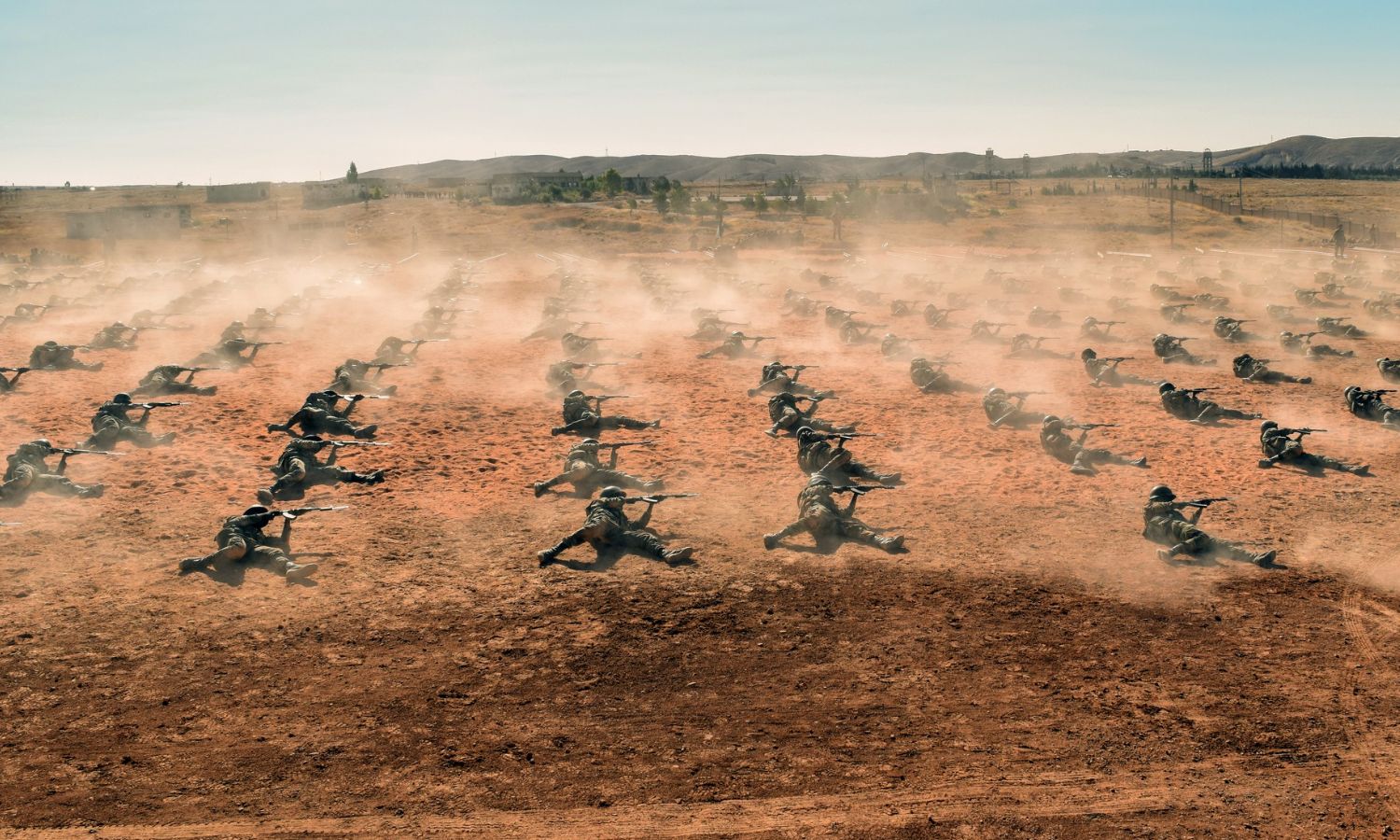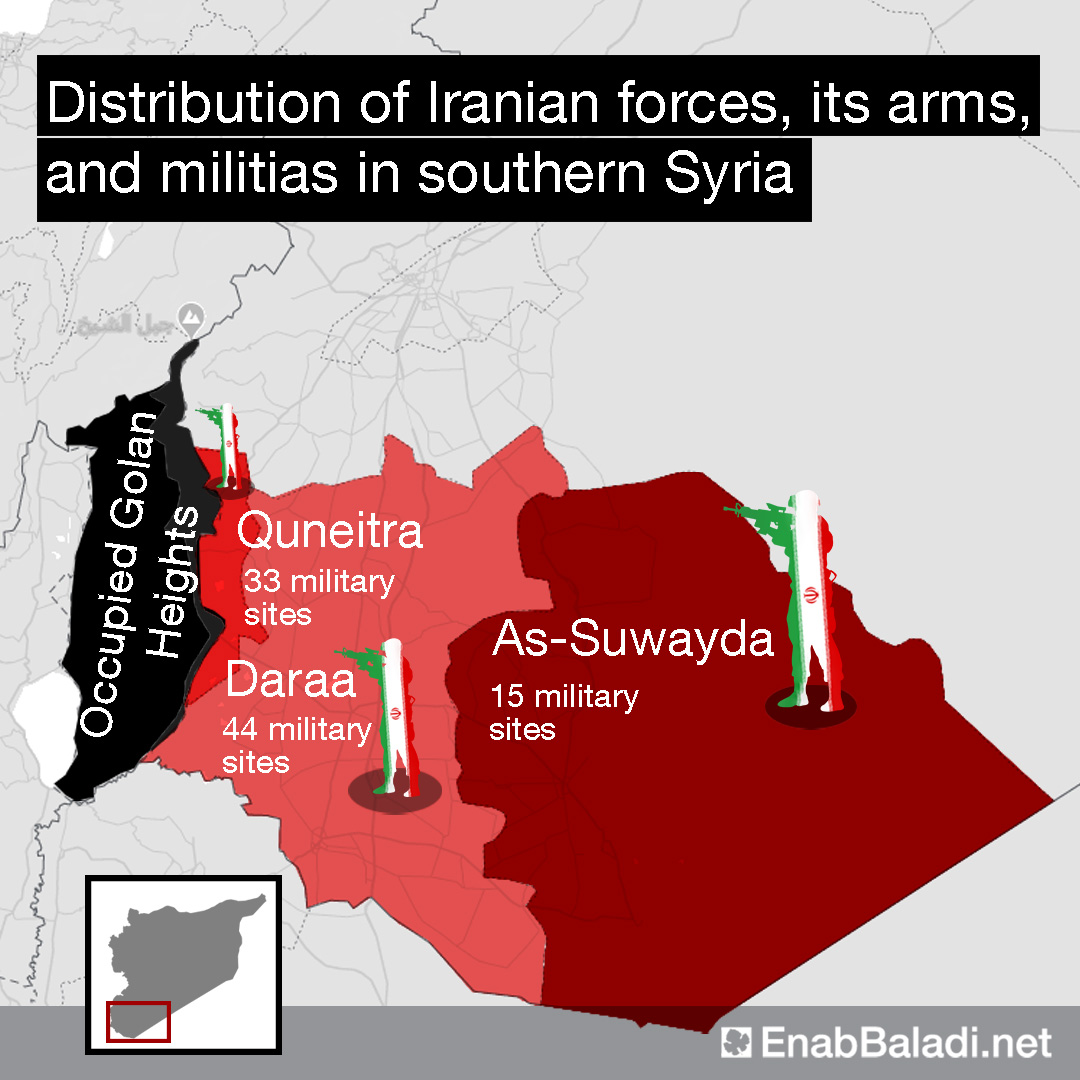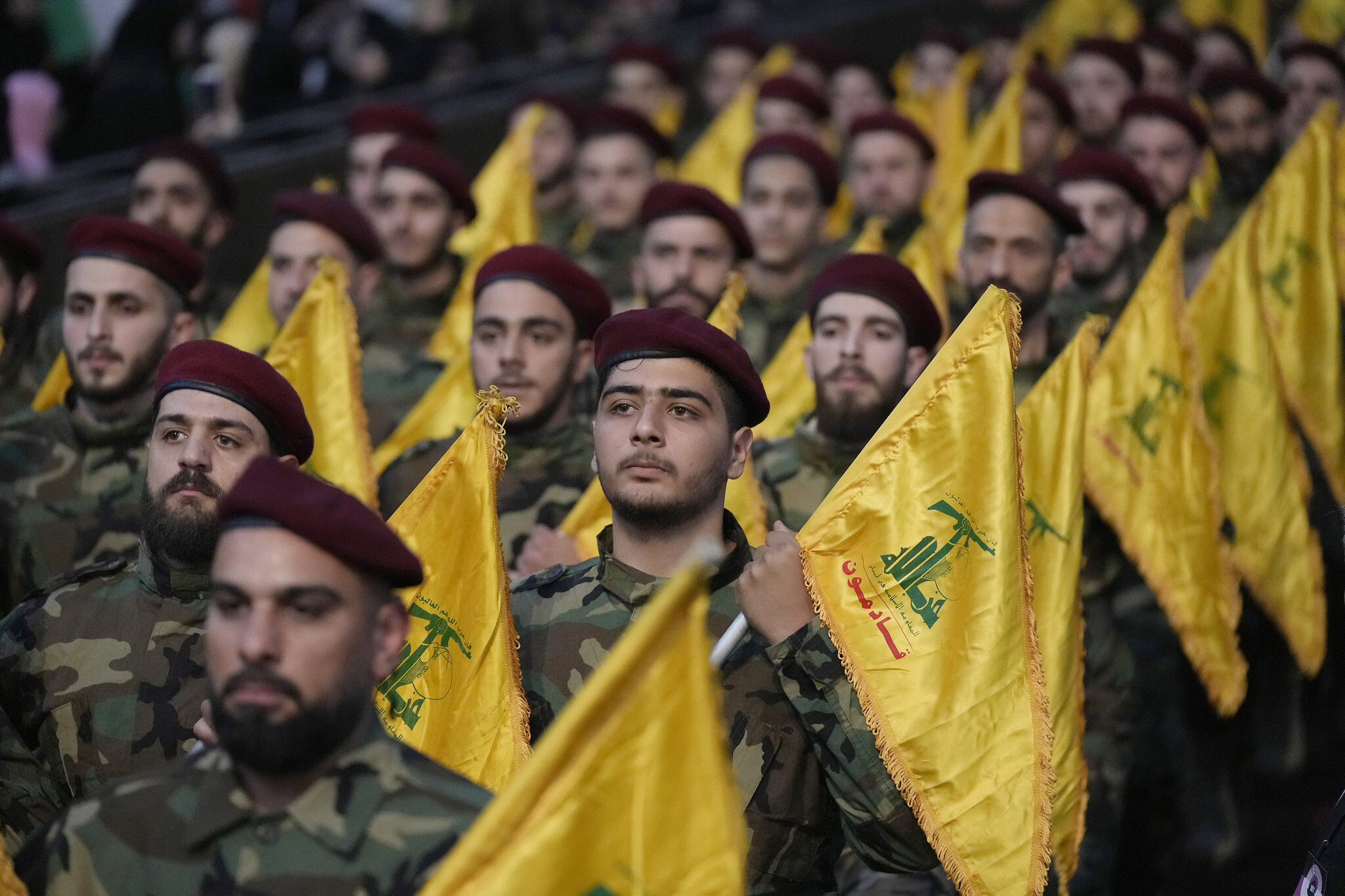


Forces from the Syrian regime army perform military demonstrations during the graduation of the officer cadets - July 15, 2023 (Regime’s Defense Ministry)


Hussam al-Mahmoud | Hassan Ibrahim | Khaled al-Jeratli
On October 7, the occupied Palestinian territories witnessed unprecedented escalation, this time initiated by the Izz ad-Din al-Qassam Brigades (the military arm of the Islamic Resistance Movement (Hamas), without prior preparation, which was met with a violent Israeli escalation that resulted in military air targeting of residential neighborhoods and vital facilities in the Gaza Strip. This comes as Israel threatens a ground invasion after cutting off water, electricity, and livelihoods amid international political mobilization to serve the Israeli narrative.
Gaza’s bloodbath produced political alignments at the Arab level around the Palestinian issue, affecting the Syrian reality, which is geographically adjacent, and the “resistance narrative” based on fighting Israel, which the regime exports along with its Lebanese ally, Hezbollah.
In the face of these developments, the Syrian regime has so far distanced itself from opening a northern front, despite being exposed during the days of escalation to Israeli bombing of Damascus and Aleppo airports, and has contented itself with official messages of solidarity, in consultation with its ally Iran, which has influence on the border strip with the occupied Golan Heights.
In this file, Enab Baladi discusses the potential impact on Syria as a result of the Israeli aggression on Gaza, the connection of the military escalation to the Iranian presence in Syria, and the influence of Hezbollah in light of the threats seeking to remove it from the conflict.

Palestinians walking through the rubble of an area destroyed by Israeli bombing in Gaza city – October 9, 2023 (EPA)
The Syrian regime cut off national mourning, which began on October 6 and was scheduled to continue until October 8, after an attack on a graduation ceremony for cadets of the Military College in central Homs city, leaving 89 people dead. Since the beginning of the escalation in occupied Palestine, its media coverage has tended to focus on news and the developments in the Palestinian operation and the corresponding Israeli escalation. This was clearly evident by comparing the coverage of the official Syrian News Agency (SANA) on October 6 and 7.
This applies to official media outlets, such as the state-run TV, Alikhbaria News Channel, Tishreen newspaper, and close media outlets, such as Al-Watan newspaper and Sham FM radio station. The Syrian Presidency also posted on its digital accounts an illustration image as a message of blessing for “Operation Al-Aqsa Flood (or Deluge).
Despite the state of Israeli caution in the occupied Golan region, the situation in that region did not reach the level of direct escalation and was initially limited to raising the Israeli state of alert in the Golan and the border triangle with Lebanon and transferring reinforcements for the elite brigades (Golani and Nahal) from the plateau to the occupied depths, with intense reconnaissance flights on the first day of the operation.
On October 10, Israeli artillery targeted various sites in southern Syria between the Daraa and Quneitra governorates against the backdrop of shells being launched from Syrian territory towards the occupied Golan Heights.
Enab Baladi’s correspondent in the southern Daraa governorate reported at the time that the sounds of bombing rang out in the area at that time.
The head of the Arab media branch of the Israel Defense Forces (IDF), Avichay Adraee, said on the social media platform X that the launching of mortar shells was detected from within Syrian territory towards Israel, and they apparently landed in open areas.
Adraee added in a separate post that the Israeli forces responded with artillery shelling and mortar fire towards the sources of the fire inside Syrian territory.
A source in southern Syria told Reuters that a Palestinian faction had fired three rockets toward Israel.
On the evening of October 7, the head of the Syrian regime, Bashar al-Assad, received a phone call from the president of the Emirates, Mohammed bin Zayed, during which developments in the Palestinian territories were discussed. This was followed, on the 12 of the same month, by another call with the Iranian president, Ibrahim Raisi, to discuss the same file, with both parties emphasizing the position in support of the Palestinian people and legitimate resistance, in addition to emphasizing that “Zionist policies” are what cause the bloodshed, according to what was reported by the Syrian Presidency.
On October 13, al-Assad received the Iranian Foreign Minister, Hossein Amir-Abdollahian, in Damascus.
SANA reported that al-Assad affirmed his support for the Palestinian people and their legitimate struggle against the Israeli occupation to obtain their rights that have been stolen for more than seven decades, stressing the danger and bloodiness of what the Israeli army is doing.
After Damascus, Abdollahian visited Lebanon and met with the Secretary-General of Hezbollah, Hassan Nasrallah, and said from Beirut, “We came to Beirut to announce with a loud voice that we, along with Islamic countries and governments, will not tolerate the crimes of the Zionist entity against the citizens in the Gaza Strip,” according to what was reported by the Iranian News Agency (IRNA).
The Israeli focus on bombing, escalation, and displacement in the Gaza Strip did not distract the Israeli aircraft from the targets it repeatedly bombed in Syria.
Aleppo and Damascus airports were subjected to a simultaneous attack, the first of its kind, on October 12, before the Iranian Foreign Minister’s plane arrived, which led to its return.
SANA quoted a military source as saying, “The Israeli enemy simultaneously carried out an air attack with bursts of missiles, targeting the international airports of Aleppo and Damascus, which led to damage to the airports’ landing strips and them being out of service.”
A “high-ranking” security source told the Russian Sputnik agency that Israeli aircraft launched a number of missiles from above the occupied Palestinian territories, targeting the vicinity of Damascus Airport, and other aircraft targeted Aleppo International Airport with guided missiles from above the territorial waters, off the Syrian coast.
The Israeli Channel 10 also quoted the Israeli army spokesman, in a rare admission, that the bombing of Aleppo and Damascus airports came in response to the firing of mortar shells from Syria, vowing to destroy more targets in the coming days.
Israel does not usually claim responsibility for its bombing of military sites and points in regime-controlled areas and is content with reporting the Syrian regime’s coverage of news of the bombing without denying it at the same time.
On October 3, Israel bombed the vicinity of Deir Ezzor governorate, northeastern Syria, and at that time, Enab Baladi’s correspondent in the region reported the presence of wounded Iranians, as confirmed by a medical source from inside the hospital, who requested to remain anonymous for security reasons, without specifying the number of wounded, at a time when regime forces surrounded the hospital.
The Israeli escalation in Gaza and the skirmishes on Lebanon’s borders with the occupied Palestinian territories opened the door to questions related to the possibility of launching an escalation from the Syrian territories towards the occupied territories on the Golan front.
Sam Heller, a research fellow at Century International think tank who specializes in Syrian affairs, ruled out this hypothesis.
The Beirut-based analyst told Enab Baladi, “I do not expect the Syrian army to intervene against Israel itself, with the development of the conflict in Gaza and the possibility of its spread at the regional level.”
Heller did not rule out that other armed factions operating in Syria could join the conflict, as happened a few days ago, without knowing whether all the factions now in Syria (non-Syrian factions specifically) will respect and adhere to Damascus’ decision in this regard, or if some of these factions may act independently.
For his part, Nader al-Khalil, a research fellow at the Omran Center for Strategic Studies, considered that using Syria as a battlefield raises a question about the extent of the Syrian regime’s ability to restrict the freedom of movement of Iranian militias in southern Syria.
According to al-Khalil, it is difficult to determine the extent of al-Assad’s ability to curb the Iranians and their influence within the areas under his control, but currently available indicators indicate that Tehran is capable of activating the Golan front if it wants and that it may actually use it in the near future, if the pressure on Gaza increases in a way that Tehran can no longer bear the political and moral cost, as the leader of the “Axis of Resistance” to which the Hamas movement is affiliated.

Forces from the Syrian regime army perform military demonstrations during the graduation of the officer cadets – July 15, 2023 (Regime’s Defense Ministry)
There were conflicting reports about Iran’s involvement in planning the Al-Aqsa Flood operation through newspapers that held Tehran responsible for coordinating the operation and standing behind it, based on statements by Iranian officials and those close to Iran, which were met with American and Iranian denials as well.
Iran supports Palestinian “resistance” groups and movements, including “Hamas,” “Islamic Jihad,” and the “Popular Front for the Liberation of Palestine,” and provides about $100 million annually to them, according to a 2020 US State Department report.
The Wall Street Journal reported on October 8 that “Iran helped plot the attack on Israel over several weeks,” saying the Islamic Revolutionary Guard Corps gave the final go-ahead in Beirut one week before Hamas launched Operation Al-Aqsa Flood.
The newspaper quoted members of Hamas and Hezbollah as saying that officers from the Iranian Revolutionary Guard had worked with Hamas on the attack since last August, and the meetings continued on a regular basis every two weeks.
Some of these meetings were attended by Hassan Nasrallah, the Secretary-General of Hezbollah, Ziad Nakhalah, leader of Islamic Jihad, and Saleh al-Arouri, the deputy head of the Political Bureau of Hamas and the founding commander of Izz ad-Din al-Qassam Brigades, in addition to Abdollahian, the Iranian Foreign Minister.
Quoting an Iranian official, The Wall Street Journal said that if Iran was exposed to an Israeli attack, it would respond from Lebanon, Yemen, and Iran and would send Iranian fighters from Syria to attack cities in northern and eastern Israel.
US State Department spokesman Matthew Miller said that Iran may have been aware of the preparations for the Hamas operation against Israel but did not know its details in terms of precise timing or size.
He added that Washington has no information or evidence indicating that “Iran directed or organized the attack carried out by Hamas.”
US Defense Secretary Lloyd Austin said that his country did not see any Iranian involvement in planning or carrying out the attack on Israel, adding that his country “will remain focused on this matter” because “Iran has a long record of supporting Hamas.”
After Iran was accused of planning the attack, Iranian Foreign Ministry spokesman Nasser Kanaani said that any “stupid action against Iran will be met with a devastating response.”
For his part, the Iranian guide, Ayatollah Ali Khamenei, denied Tehran’s involvement in the operation and praised what he described as the “irreparable” military and intelligence defeat of Israel, recalling Iranian support and defense of Palestine and its struggles, according to a televised speech on October 10.
Abdollahian said that all options are possible if the “war crimes of the Zionist entity” do not stop, and if the crimes against the Palestinians continue, this will be met with a response from “the rest of the axes,” during a press conference in Beirut with his Lebanese counterpart, Abdallah Bou Habib, on October 13.
Compared to the foreign military forces present in Syria, Iran has great influence in the cities and towns of southern Syria through its arms and militias from the Iranian Revolutionary Guard (IRG) and the Lebanese Hezbollah group, and the number of its military sites is 44 in Daraa, 33 in Quneitra, and 15 in As-Suwayda, according to a research analysis by the Jusoor Center for Studies in cooperation with the InformaGENE Data Analysis Foundation.
Since the beginning of the Syrian revolution in 2011, Iran has sought to form local military entities, to form groups auxiliary to the regime forces, and has been able to recruit young men in them. One of the most prominent formations in southern Syria is the “Golan Regiment,” run by Hezbollah. These groups spread in areas near the border strip with the occupied Syrian Golan Heights.
Enab Baladi’s correspondent in Quneitra said that the movement of forces affiliated with Hezbollah and Iran declined months ago after an Israeli artillery bombardment, and with the acceleration of military events in Gaza, military movements of groups known for their affiliation with Hezbollah returned in the areas of Qars al-Nafal, Buraiqa, and Bir Ajam, Khan Arnabah, and Ghadeer al-Bustan.
 Open Scenarios
Open ScenariosMahmoud al-Bazi, a researcher on Iranian affairs, pointed out that there are indications of a redeployment of armed groups supported by Iran, which means that Tehran will send military reinforcements to southern Syria in anticipation of any future developments that might push it to open the Syrian front against Israel.
Al-Bazi told Enab Baladi that Iran’s withdrawal of forces will be from the north-western front of Syria and not from the eastern front because Deir Ezzor represents a high-level strategic importance, and it is possible that the United States will exploit this region to sever the vital link between Syria and Iraq, which is considered an important artery of flow along the border.
For his part, an Iranian affairs expert, Mustafa al-Nuaimi, suggested that Iran would exploit the great popular clamor in support of Jerusalem and Al-Aqsa to reposition and spread inside Syria under the pretext of supporting the “Flood of Al-Aqsa.”
He pointed out that Iran’s movements in Syria today may have differed after the almost complete closure of the Al-Qaim border crossing with al-Bukamal (where the Iraqi counter-terrorism forces are stationed).
Al-Nuaimi added, in an interview with Enab Baladi, that the Israeli air strikes that targeted the Aleppo and Damascus international airports may have a negative impact on the Iranian project to prevent the arrival of any arms shipments from Tehran to Damascus.
|
Until now, there are no indications that Iran will use Syrian territory as a launching pad for its military operations against Israel so as not to embarrass the regime so that it is not an Israeli target, which affects Iran’s project in the Arab region. Mustafa al-Nuaimi – Expert in the Iranian affairs |
Al-Nuaimi believes that Iran considers the Syrian regime a key stake in the Arab region, and therefore, it will not sacrifice those gains it has achieved over the years for the sake of a clash that may be considered a “loss” by Iranian decision-makers, and therefore it will not take that step because it will be harmed.
Not using Syrian territory does not mean that Iran will not respond to sources of fire from within the Palestinian territories towards Syria, according to al-Nuaimi, who pointed out the possibility of targeting at a higher frequency by both parties, but without this achieving any tactical goals in the foreseeable future.
Nader al-Khalil, Omran’s research fellow, told Enab Baladi that Iran is repositioning militias and fighters supported by it to make them ready to move on the borders of the occupied Golan if Tehran takes a decision to use this front to put pressure on Israel.
Al-Khalil considered that the firing of “mortar” shells from Syria on the occupied Golan Heights is a provocation of limited effect and value, but it indicates an Iranian willingness to activate the Golan front to relieve pressure on Gaza, if the Israelis continue their war according to the “scorched earth” principle on the Strip, in a way that threatens the ability of the Hamas movement to remain steadfast in the long term.
The research fellow believes that the continuation of the Israeli war on the Gaza Strip, the emergence of indicators of a possible collapse of the Hamas resistance, and the significant increase in the number of Palestinian deaths will make the matter a source of great embarrassment for the “resistance” axis, led by Iran. This is what Abdollahian said explicitly during his visit to Beirut, where he stressed that “the continuation of crimes against the Palestinians will receive a response from (the rest of the axes).”

Israeli army soldiers near a self-propelled howitzer (fight tank), near the border with Gaza – October 12, 2023 (AFP)
|
The possibility of Iran attacking Israel from Syria is slim, and if Tehran decides to activate other fronts to relieve pressure on Gaza, Syria will take precedence over Lebanon because a comprehensive war between Hezbollah and Israel would be very costly at the level of the party’s popular incubator, while the cost may be less in Syria from Tehran’s perspective and Hezbollah’s interests. Nader al-Khalil – Research Fellow at the Omran Center for Strategic Studies |
While the military vehicles were active in the south of the occupied Palestinian territories, attention turned to the concentration points of the Lebanese Hezbollah members, which did not engage in the battles and were content with political statements about the escalation and military skirmishes as part of the responses between the two sides.
Mutual bombing took place in the southern Lebanese regions between Hezbollah and the Israeli army, which suggested that a confrontation had broken out between the two sides, but the party did not take a clear position on the military level regarding the course of events, except for its response to attacks launched by Israeli units on southern Lebanon.
Iranian affairs analyst Mahmoud al-Bazi told Enab Baladi that Israel is trying to test its readiness on its northern border, while Hezbollah is trying to send messages to discourage Israel from implementing a large-scale ground military campaign in the Gaza Strip.
Al-Bazi believes that the expansion of the confrontations, if it happens, will be gradual, with Hezbollah starting the fighting and other Iranian fronts in Syria, Iraq, and Yemen joining it. However, Iran’s intervention will only occur in the final stage if exposed to an attack.
Mustafa al-Nuaimi, a scholar in Iranian affairs, believes, for his part, that the mutual targeting, whether by Israel or Hezbollah, is still within the concept of “political messages with military tools.”
Al-Nuaimi told Enab Baladi that both parties are putting pressure on the fronts with the aim of achieving the highest gains in this file despite the fact that the state of discomfort for the Israeli army has become clear. But addressing the Hezbollah file is one of Iran’s goals, and it may contribute in one way or another to weakening its power in the various areas of its deployment in Syria or Lebanon.
Politician and former member of the Lebanese Parliament, Mustafa Alloush, told Enab Baladi that Iran’s entry into the Palestinian cause and its exploitation had prevented finding solutions to it.
He added that all parties related to the conflict taking place in Palestine are in real trouble with the developments that the region has witnessed, especially Israel, which now needs an “almost impossible victory” to restore its reputation and the confidence of its citizens.
Alloush believes that Iran’s followers, led by the Lebanese Hezbollah and other militias, are in a critical position, as they are standing by today and will lose their fame associated with the Palestinian cause.
Based on the situation the parties are going through, Alloush said, “the greatest possibility” is that the war will expand and Hezbollah will be immersed in it, and perhaps Syria later, which will be disastrous for Lebanon in particular.
In an article published by The Foreign Policy, a researcher at the Center for Strategic and International Studies, Daniel Byman, described Hezbollah as “more skilled” than other armed groups, and perhaps the most skilled in the world, as it fought against Israel in 2006, and its forces participated in the Syrian war almost since its beginning in 2011, proving to be a “stabilizing force” for the reeling al-Assad regime.
The tasks included patrolling the Syrian-Lebanese border, fighting “Sunni rebels” in several Syrian cities, and using drones to strike targets from the Islamic State group, according to Byman, who linked the relationship between Hezbollah and the regime to what is happening today.
At the same time, al-Nuaimi ruled out direct intervention by Hezbollah and the regime in the war at the official level, but the regime would help the party and other unofficial militias to open fighting fronts against Israel.
Regarding the organic connection between southern Syria and southern Lebanon, researcher al-Bazi said that there has been no connection between the two souths since 2006, as Syria does not view Lebanon as linked to its national security, and there is no need for the two sides to participate in the fighting fronts if one of them opens.
At the same time, al-Bazi believes that Syrian involvement in this type of confrontation may be limited to the informal aspect, as it is linked to broader developments related to the intervention of other parties besides Israel, such as the United States.
He added that the threats issued by the Iraqi Shiite groups and the Houthi “Ansar Allah” group in Yemen to intervene if the United States gets involved in the war must be heeded, as these groups can activate the fronts by targeting the US army bases in the region, and not engaging directly in a conflict with Israel, which is referred to as “limited confrontations.”
In a report issued by the Israeli Alma Research Center in 2020 about the presence of Iranian-backed militias in southern Syria, most notably Hezbollah, it said that there are 58 sites and regions where these units are deployed, and they are distributed in 28 places where a unit called “Southern Command” is stationed. In addition to 30 other locations where there are “terrorist cells” belonging to a unit called “The Golan File.”
The “Southern Command” unit is considered completely affiliated with Hezbollah, and the majority of its members are Lebanese, and they are responsible for managing the southern Syrian file.
Its main role is to establish operational infrastructure for all Hezbollah activities in southern Syria, with a focus on the border region with Israel, according to Alma Center.
The center added that among the tasks of this group is to provide the appropriate environment for the pro-Iranian forces to immediately launch any campaign against Israel if they receive the order to do so.

Hezbollah fighters commemorate Jerusalem Day in the southern suburb of Beirut, Lebanon – April 14, 2023 (AP)
if you think the article contain wrong information or you have additional details Send Correction